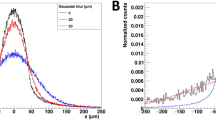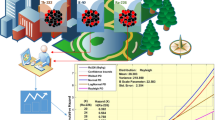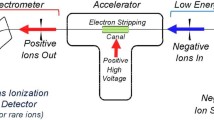Abstract
Direct measurement of tritium atoms by accelerator mass spectrometry (AMS) enables rapid low-activity tritium measurements from milligram-sized samples and permits greater ease of sample collection, faster throughput, and increased spatial and/or temporal resolution. Because existing methodologies for quantifying tritium have some significant limitations, the development of tritium AMS has allowed improvements in reconstructing tritium exposure concentrations from environmental measurements and provides an important additional tool in assessing the temporal and spatial distribution of chronic exposure. Tritium exposure reconstructions using AMS were previously demonstrated for a tree growing on known levels of tritiated water and for trees exposed to atmospheric releases of tritiated water vapor. In these analyses, tritium levels were measured from milligram-sized samples with sample preparation times of a few days. Hundreds of samples were analyzed within a few months of sample collection and resulted in the reconstruction of spatial and temporal exposure from tritium releases. Although the current quantification limit of tritium AMS is not adequate to determine natural environmental variations in tritium concentrations, it is expected to be sufficient for studies assessing possible health effects from chronic environmental tritium exposure.



Similar content being viewed by others
References
Covello VT, Merkhofer MW (1993) Risk assessment methods—approaches for assessing health and environmental risk. Plenum, New York, 318 pp
Louvar JF, Louvar BD (1998) Health and environmental risk analysis: fundamental and applications. Prentice Hall PTR, New Jersey, 678 pp
Miller CW, Smith JM (1996) Health Phys 71:420–424
Straume T et al (1996) Challenges in dose reconstruction: examples from Chernobyl Hiroshima, biomarkers, and environmental materials, UCRL-JC-125029, Lawrence Livermore National Laboratory, 30 pp
Griffith RV (1998) Radiat Prot Dosim 3–9
Thompson CB, McArthur RD (1996) Health Phys 71:470–476
Whicker FW et al (1996) Health Phys 71:477–486
Kirchner TB et al (1996) Health Phys 71:487–501
Simon SL, Graham JC Dose (1996) 71:438–456
Musolino SV et al (1997) Health Phys 73:651–662
Anspaugh LR, Bouville A (1995) United States-assisted studies on dose reconstruction in the former Soviet Union, UCRL-JC-122291, Lawrence Livermore National Laboratory, 8 pp
Akiba S (1991) J Radiat Res 32:339–346
Ezaki H et al (1991) J Radiat Res 32:193–200
Straume T et al (2003) 424:539–542
Nell JV (1998) Proc Natl Acad Sci USA 95:5432–5436
Kellerer AM (2000) Radiat Environ Biophys 39:17–24
Gavrilin YI et al (1995) Chernobyl accident: reconstruction of thyroid dose for inhabitants of the Republic of Belarus, UCRL-JC-122293, Lawrence Livermore National Laboratory, 97 pp
Ispenkov EA et al (1996) Dose reconstruction protocol: World Health Organization international programme on the health effects of the Chernobyl accident, UCRL-AR-125179, Lawrence Livermore National Laboratory, 35 pp
Wing S et al (1997) Environ Health Perspect 105:52–57
Talbott EO et al (2000) Environ Health Perspect 108:545–552
Shipler DB et al (1996) Health Phys 71:532–544
Meyer KR et al (1996) Health Phys 71:425–437
Ripple SR et al (1996) Health Phys 71:502–509
Widner TE et al (1996) Health Phys 71:457–469
Degteva MO et al (1996) Dose reconstruction for the Ural population, UCRL-PROP-123713, Lawrence Livermore National Laboratory, 176 pp
Bougrov NG et al (1998) Health Phys 75:574–583
Papp Z (1998) Health Phys 74:393–397
Tung CJ et al (1998) Health Phys 74:707–713
Environmental Protection Agency (2002) What is an exposure assessment? Office of Pollution Prevention and Toxicshttp://www.epa.gov/opptintr/exposure/docs/exposurep.htm, June 13, 2002
Anspaugh LR (1996) Technical basis for dose reconstruction, UCRL-JC-123714, Lawrence Livermore National Laboratory, 36 pp
Amiro BD (1997) J Environ Radioact 36:109
Thorburn PJ et al (1993) J Hydrol 150:563–587
Murphy CE et al (1982) Nucl Saf 23:677–684
Raney F, Vaadia Y (1965) Plant Physiol 40:383–388
Erdman JA, Christenson S (2000) Ground Water Monit Rem 20:120–126
Kylin H et al (1996) Fresenius J Anal Chem 356:62–69
Nabais C et al (2000) Sci Total Environ 232:33–37
Schaumloffel JC et al (1998) J Environ Qual 27:851–859
Simonich SL, Hites RA (1995) Environ Sci Technol 29:2905–2914
Kigoshi K, Tomikura Y (1961) Bull Chem Soc Jpn 34:1738–1739
Brown RM (1979) Environmental tritium in trees. Behavior of Tritium in the Environment. International Atomic Energy Agency, Vienna, pp 405–418
Kozak K, Biro T (1984) Health Phys 46:193–203
Kozak K et al (1986) Acta Phys Hung 59:59–62
Kozak K et al (1989) Radiocarbon 31:766–770
Kozak K et al (1993) J Environ Radioact 19:67–77
Yamada Y et al (1989) J Radioanal Nucl Chem 132:59–65
Kalin RM et al (1995) Fusion Technol 28:883–887
Fuma S, Inoue Y (1995) Appl Radiat Isotopes 46:991–997
Muller RA (1977) Science 196:489–494
Vogel JS et al (1995) Anal Chem 67:A353–A359
Gray J, Song SJ (1984) Earth Planet Sci Lett 70:129–138
Schimmelmann A, Deniro MJ (1993) Anal Chem 65:789–792
White JW et al (1994) Geochim Cosmochim Acta 58:851–862
Terwilliger VJ, Deniro MJ (1995) Geochim Cosmochim Acta 59:5199–5207
Chiarappa-Zucca ML et al (2003) Anal Chem 74:6285–6290
Middleton R et al (1990) Nucl Instrum Methods Phys Res B 47:409–414
Theodorsson P (1999) Appl Radiat Isotopes 50:311–316
Surano KA et al (1992) J Radioanal Nucl Chem 161:443–453
Beyerle U et al (2000) Environ Sci Technol 34:2042–2050
Neary MP (1997) Radioact Radiochem 8:23–35
Nimz GJ, Thompson JL (1992) Underground radionuclide migration at the Nevada test site, DOE/NV-346 UC-703. United States Department of Energy—Nevada Field Office, 15 pp
Guell MA, Hunt JR (2003) Water Resour Res 39:1175–1184
Love AH et al (2002) Environ Sci Technol 36:2848–2852
Lawrence Berkeley National Laboratory Site (1965–2000) Environmental Report LBL-27170
Love AH et al (2003) Environ Sci Technol 37:4330–4335
Love AH (2002) PhD thesis, University of California at Berkeley, 172 pp
Acknowledgements
Supported by the Center for Accelerator Mass Spectrometry Mini-grant Program, the Laboratory Directed Research and Development (LDRD) Program (00-ERI-01), and the Sabbatical Leave Program at Lawrence Livermore National Laboratory. Additional funding from the National Institute of Environmental Health Sciences, Superfund Basic Research Program, P42 ES04705. This work was performed under the auspices of the US Department of Energy by the University of California, Lawrence Livermore National Laboratory under Contract W-7405-Eng-48. Discussions with S. Ring Peterson were extremely helpful in understanding the interaction of tritiated water vapor with vegetation. Additional thanks go to John Southon, Tom Guilderson, Tom Brown, Marina Chiarappa-Zucca, and Karen Dingley from Lawrence Livermore National Laboratory, and Gary Zeman, Ron Pauer, and Linnea Wahl from Lawrence Berkeley National Laboratory Environment, Health, and Safety Division
Author information
Authors and Affiliations
Corresponding author
Rights and permissions
About this article
Cite this article
Love, A.H., Hunt, J.R., Vogel, J.S. et al. Improving tritium exposure reconstructions using accelerator mass spectrometry. Anal Bioanal Chem 379, 198–203 (2004). https://doi.org/10.1007/s00216-003-2425-9
Received:
Revised:
Accepted:
Published:
Issue Date:
DOI: https://doi.org/10.1007/s00216-003-2425-9




